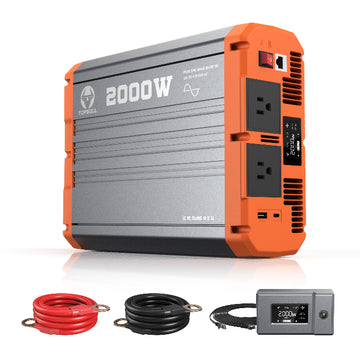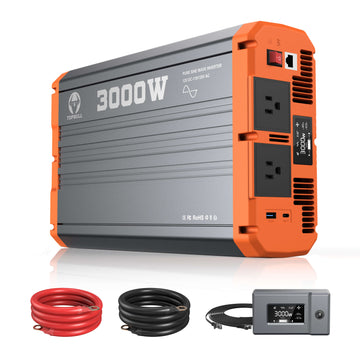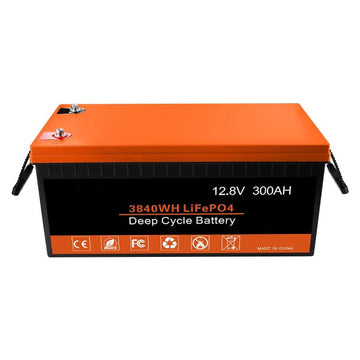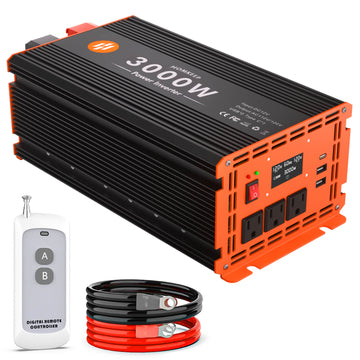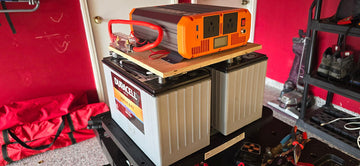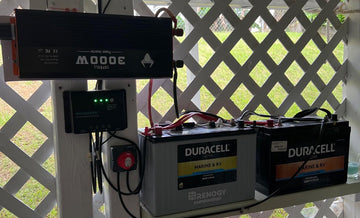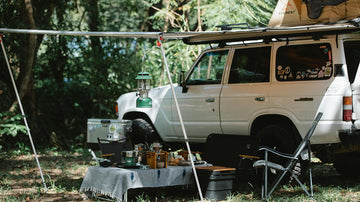When choosing an inverter, you often see two parameters: rated and peak power. But what do these numbers mean? And how do they affect your power needs? In this guide, we'll analyze the key differences, reveal common mistakes, and provide actionable steps to make your inverter meet both continuous and instantaneous power needs.
Understanding inverter power basics
What is rated power?
Rated power, also known as continuous power, is the maximum amount of power that an inverter can consistently deliver over a long period, usually in watts (W). Under normal operating conditions, the inverter can continuously power your equipment as long as the load power does not exceed this rating.
The power rating guarantees the stability of your equipment over a long period. If the total load exceeds this value, the inverter will be damaged due to constant overloading.
What is Peak Power?
Peak Power, also known as Surge Power, represents the maximum power value that the inverter can deliver in a short period (usually 0.5~5 seconds). The peak power is set to cope with the inrush current that some appliances may generate momentarily during startup, so that the appliance can start up normally only if the peak power of the inverter is greater than the startup power of the appliance. After full startup, the current will return to the normal level.
For example, a refrigerator may normally run at only 150W, but the moment the compressor is started, its power may instantly soar to 1000W or more. If the inverter's maximum power is insufficient to meet this start-up demand, the unit may not start, even if the rated power is adequate.
When selecting an inverter and determining the amount of power required, it is important to distinguish between the rated power and the peak power of the inverter. Peak power is usually two to three times the rated power. The rated power is the power at which the inverter is stabilized over a long period, whereas the peak power is only used for short periods of high power demand.
Learn More: How does an inverter work?
What causes the inverter to overload?
Inverter overload is the most common problem that users face during the process. Many people think that overload is just connecting too much equipment, but in reality there are many reasons for overload. The essence can be summarized into two types of problems: high current consumption type overload and output voltage drop type overload.
High current consumption leads to power overload.
This is the most common form of overload. When the total power of the appliances you connect exceeds the rated power of the inverter, the inverter triggers protection to automatically cut off power because of the power excess. The inverter case gets hot, the connecting wires or terminals melt and burn due to the excessive current.
This overload is common in the following scenarios:
- Multiple power-consuming devices are running at the same time and the accumulated power is exceeded.
- Ignoring the inrush current of the equipment.
- Ignoring the inverter's ability to operate continuously and running at full load for an extended period.
Overload triggered by a drop in output voltage
When the input voltage or current is lower than the demand, the inverter output voltage decreases. At this point, the alarm light flashes, the lights dim, the motor speed drops, and the electronic equipment shuts down automatically.
This usually happens in the following situations:
- The battery voltage is insufficient to provide enough current
- Connection wires are too thin or too long, resulting in severe voltage drop
- High ambient temperatures, causing the inverter's internal components to derate
- Exceeding the inverter's voltage regulation capability, with the output voltage falling below the minimum operating voltage of the device

Peak power of common devices
Understanding the peak power of commonly used appliances is a critical step in selecting an inverter. The power requirements of different appliances vary dramatically when starting or running. Appliances can be broadly categorized into three groups in terms of technical performance:
- Inductive loads: Inductive loads, including electric motors or compressors, require a great deal of power at the moment of start-up, and the peak power of the inverter must cover this demand.
- Capacitive loads: Electronic devices may have short surges due to internal capacitor charging, but usually do not require special treatment.
- Resistive loads: The starting power of these devices is the same as the operating power, so there is no need to reserve additional peak capacity.
Generator-type equipment (e.g. refrigerators, air conditioners, water pumps) need to overcome motor inertia when starting, which can generate up to 3 to 5 times the rated power starting current for a short period.
Below are the peak inrush current power consumption of some common devices:
| Appliance Type | Rated Power (W) | Peak Power (W) |
| Refrigerator | 150 | 900 |
| Microwave oven | 1000 | 1500 |
| Air conditioner (1 HP) | 1200 | 3000 |
| Washing machine | 500 | 1000 |
| Water pump | 750 | 220 |
| hand drill | 600 | 1200 |
Which appliances have almost no current surge?
Resistive and capacitive loads start and run with very smooth currents and almost no inrush current. These two types of loads have relatively low inverter requirements for smooth starting and stable power. Let's take a look at the most common types of low-surge loads:
| Appliance Type | Rated Power (W) | Peak Power (W) |
| LCD TV | 150 | 180 |
| Laptop | 60 | 70 |
| Cell Phone Charger | 10 | 12 |
| LED bulb | 10 | - |
| Electric Heater | 1500 | - |
| Electric kettle | 1800 | - |
| Electric Oven | 2000 | - |
How to choose the inverter for your power needs
In practice, the synergy between rated power and peak power is crucial. For example, when selecting an inverter for a home solar system, if one focuses only on the rated power and ignores the peak demand of equipment such as air conditioners and water pumps, the system may trip frequently when the equipment starts up; conversely, if one overpursues the peak power and ignores matching the rated power for day-to-day operation, one may pay extra costs for unnecessary performance redundancy. Therefore, understanding the balance between the two is the first step in optimizing system efficiency and reliability.
When selecting an inverter, its power should be higher than the starting power of household appliances. Most appliances in a home or RV consume a lot of power quickly during startup. This is especially true of refrigerators, microwave ovens, power tools and air conditioners. While these appliances may only consume 1,000 to 1,500 watts of power during normal operation, they can require double or even triple that amount of power within seconds of startup. If your inverter can't provide enough surge power at the critical moment, the appliance may not start, causing the entire system to shut down and even placing a long-term load on the batteries and inverter.
Our recommended inverter models
To seamlessly handle continuous and surge requirements, especially in LiFePO4 battery-based systems, we offer several high-performance inverters designed for off-grid, RV, solar, and home backup use.

- 2000W continuous / 4000W peak
- Ideal for small RV setups
- Lightweight and efficient, compatible with all 12V batteries
- 3000W continuous / 6000W peak
- Ideal for mid-sized home systems or mobile workshops
- Advanced BMS compatibility with LiFePO4 batteries
- 4000W Continuous / 8000W Peak
- Ideal for DIY off-grid solar
- Provides additional surge margin for large air conditioning units, power tools or pumps
FAQ
Q: Can I run appliances that require more power than the inverter is rated for?
A: No. The inverter's rated power is the maximum power it can sustain and safely output. If an appliance is run over this power, it will cause the inverter to overload, automatically cut off, or even be damaged. However, if the appliance is only started instantly at the rated power, and over the rated power, but within the inverter's maximum peak power range, then it is possible to operate normally. The key is to make sure that the “peak starting power” of the appliance is within the inverter's support range.
Q: What happens to the inverter if the peak power limit is exceeded?
A: If the maximum power limit is exceeded, the inverter will usually shut down automatically or trigger overload protection damage. Some low inverters may over Some low quality predictors may overheat, burn out or fail permanently. So always make sure that the appliance starts up to not exceed the maximum power limit of the inverter.
Q: How long does the peak power of the inverter last?
A: The peak power of an inverter generally only lasts for a few seconds, usually between 1 and 5 seconds, depending on the model and design. It is designed to cope with transient surges when an appliance starts, not for long periods.

